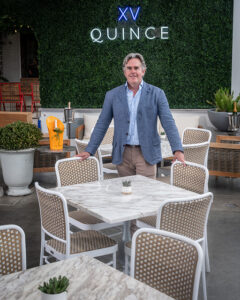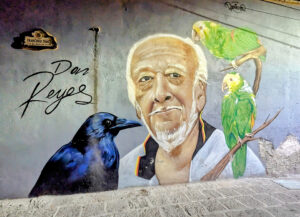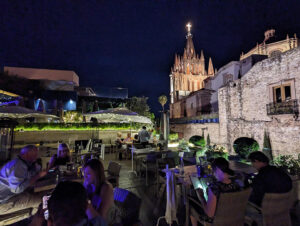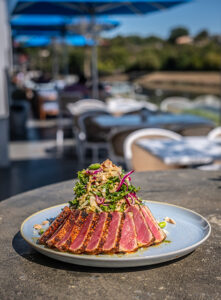
Fort Worth entrepreneur Brian Sneed finds inspiration in magical San Miguel de Allende — and the launchpad for his Quince restaurants
By Barry Shlachter

Quince owner Brian Sneed on the patio of his Fort Worth restaurant. Photo by Olaf Growald
Brian Sneed is the energy behind Quince in San Miguel de Allende, Mexico; Quince on the Trinity River in Fort Worth; and Quince Lakehouse on Lake Austin, the largest and newest. He plans a fourth restaurant at an undisclosed location, and has dropped hints it might be in New Orleans where he grew up.
Remarkably, this expanding portfolio of high-end fusion eateries with memorable views is a second act for the onetime TCU pre-med major who became a hedge fund maven.
“It was a big transformation,” he said. “My wife, Deb, knew I was done trading, like I was burnt out. Here I was sitting in front of a [computer] screen; I enjoy life too much to be doing that. I love to create and, of course, eat, and it was time to make an attempt at utilizing those self-perceived skills.”
The 52-year-old Sneed had a school-era stint as a waiter and later was a TCU Rent A Frog. But otherwise he had no hospitality experience when he decided to open a restaurant in San Miguel after leaving the turbulent hedge fund world.
He enlisted partners from among San Miguel friends who gave him the confidence to do business in Mexico.
And he had a vision. A magnificent view was a must. “I always had this outdoor, hip, elegant concept in my head for years.”
Throughout his New Orleans childhood, whenever his dentist father took the family on vacation, his mother insisted on a “room with a view.” And, like a character in E.M. Forster’s 1908 novel, she wasn’t satisfied until the view met her expectations.
“It became a joke, us changing rooms,” he said. “It was my mom’s thing, and it kind of got ingrained in me in some way. I love sunsets. It’s also an insurance policy for a restaurant — to have the best views in town.”
On business trips to Europe, he’d seek out “view destination” restaurants and couldn’t help but critique them. Views might be good but the décor lacking. The music was either off or complementing the ambience. The food could be superb or the management rested on past laurels.

San Miguel de Allende is known for its richly detailed, colorful street murals. Photo by Barry Shlachter
The quick-draw critiquing was a casual exercise until after Sneed made a big call during the 2009-2010 European debt crisis.
Trading credit default swaps (derivative contracts that serve as a sort of risk insurance on government and bank bonds), he figured Germany would “tease” European Union countries until finally supporting their financial systems. Sneed saw it as a replay of the U.S. Federal Reserve’s actions during the subprime banking crisis the year before — allowing the global financial services firm Lehman Brothers to collapse to prove a point, but letting Bear Stearns go to the precipice before finally rescuing it — and the country’s banking system.
Sneed set up his trade to “short” — or bet against — European credit debt swaps as a hedge due to the high volatility he saw coming. At the last possible moment, Germany would follow through and not allow the Greek, Italian and Spanish bonds to fail, said Sneed, who was investing millions for the TCU endowment fund among others.
Confirming his analysis were well-placed contacts including a European central bank official he had met at gold conferences — Sneed also managed a gold fund. The central banker was unaware that Sneed ran a hedge fund that traded credit default swaps.
“We were under the radar,” he said of his low-profile, Fort Worth-based hedge fund, created specifically for the debt crisis. What did the central banker say when he found out? “I don’t know if he would have cared, but I never shared that with him.”
Sneed’s last year of trading was done from San Miguel. And after that eventful call, he closed down the fund.
Ironically, he had resisted that first trip to the city in Mexico’s Central Highlands, telling his wife he preferred going to Europe. But she had rented a San Miguel vacation home with a no-refund contract.
“Why would you agree to that term?” he asked.
To which she replied, “I wrote that term, because I knew you would try to get out of going.”
Although Sneed says he easily falls in love with places, San Miguel proved a long-term deal. And he wanted to teach his kids Spanish.

Fort Worth entrepreneur Brian Sneed decided one factor beat all when he decided to open his first Quince restaurant in Mexico’s San Miguel de Allende: the view. Photo by Barry Shlachter
He ended up discussing his restaurant vision with friends, who encouraged him. The location he chose provided a striking view of La Parroquia de San Miguel Arcángel, the city’s iconic parish church with its “wedding cake” towers — pink in daylight but glowing a warm gold at night — that soar above the city. The majestic setting prompted the Robb Report in 2020 to name it the “No. 1 rooftop restaurant in the world,” echoed this year by Stockholm-based journalist Rikard Fredricson, whose genre specific website, The Rooftop Guide, scours the globe for superb, lofty venues.
There are other rooftop restaurants in San Miguel. But none quite compares to Sneed’s Quince for sheer experience.
I had no advance warning. As I entered Quince’s courtyard, a slackline performer balanced directly above, doing various dance moves and acrobatics to heart-thumping music, making the unexpected spectacle all the more dramatic.
The over-the-top performance evolved from a charity arts event with the organizer offering up a slackliner. And it became a nightly feature.
While the slackliner performed, a strolling violinist provided rousing, amplified accompaniment that only momentarily distracted diners from a truly inspiring rooftop view.
But even spectacular views don’t guarantee success. “For me, it always starts with the view,” he said, invoking his mom’s influence. “But it ends with everything else you experience.”
A crisis loomed at the start. A partner with operational experience went on vacation opening week, he said. “It was tough but it made me learn A to Z, made me not dependent on an operator.”

Quince’s menu offerings range from seafood and sushi to sandwiches, salads, pasta and chops. Photo by Olaf Growald
Then it took three years to get Quince operating as he wanted. The menu started out modern Mexican, but he wanted eclecticism with flair. So he took four chefs on a tour of his favorite culinary cities — Rome, Mexico City, Oaxaca, New York, New Orleans and Lima, Peru.
The meals I had at Quince reflected that — the colorful sushi rolls, beef filet over aji pepper risotto, tempura rock shrimp. And the desserts had familiar names but with a singular Quince approach, a black forest cake like none other.
Sneed took much care finding the site for his Fort Worth Quince, nestled between buildings that provide shade that lower temperatures on hot days by more than 10 degrees while the Trinity riverfront in the WestBend development provided an open-air, south-of-France feel.
“People asked me why I didn’t choose Dallas for Quince since it’s obviously a stronger market for hip restaurant concepts,” Sneed says.
“Financially, Dallas would be better for sure. But this is about giving my hometown something I felt was needed. We were the first in San Miguel, and now there are dozens of hip, fun rooftops that are a big draw to the city. We hope this takes off in Fort Worth and others will bring al fresco dining with an extra-experiential concept.”
